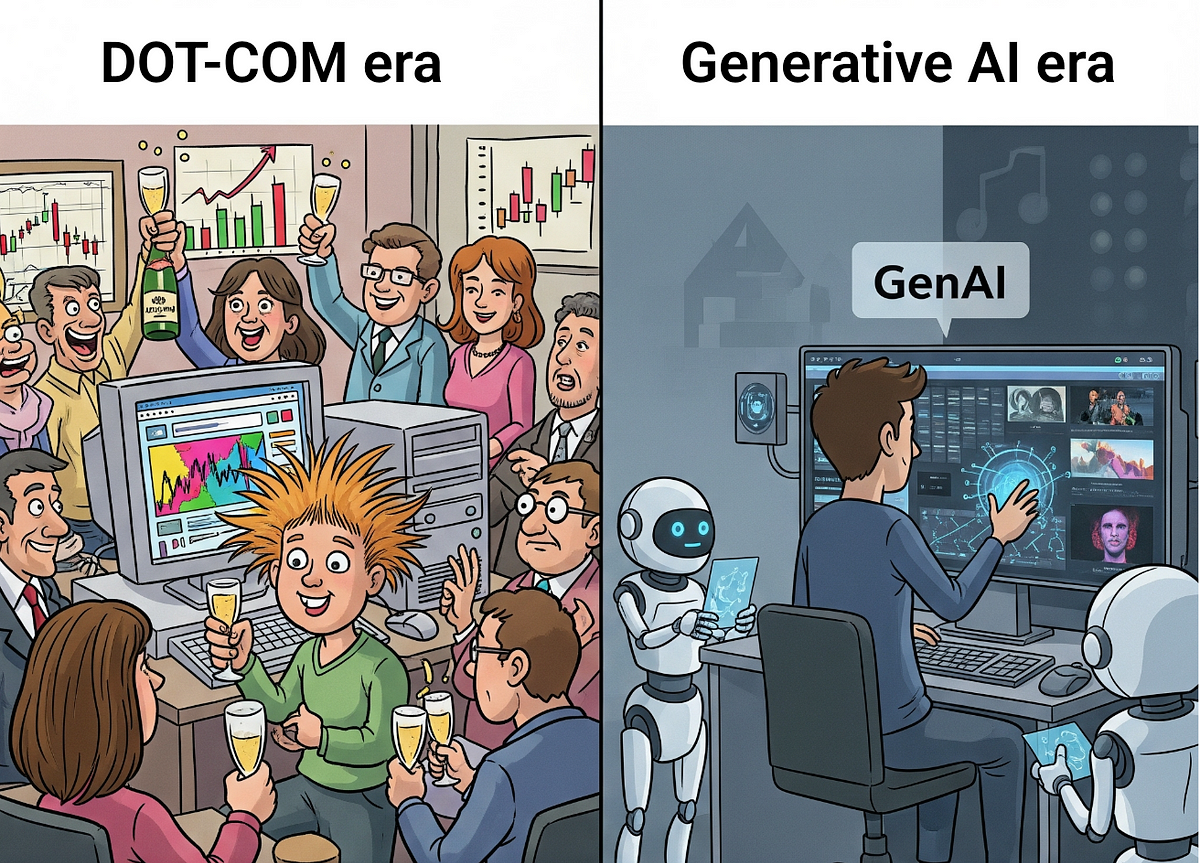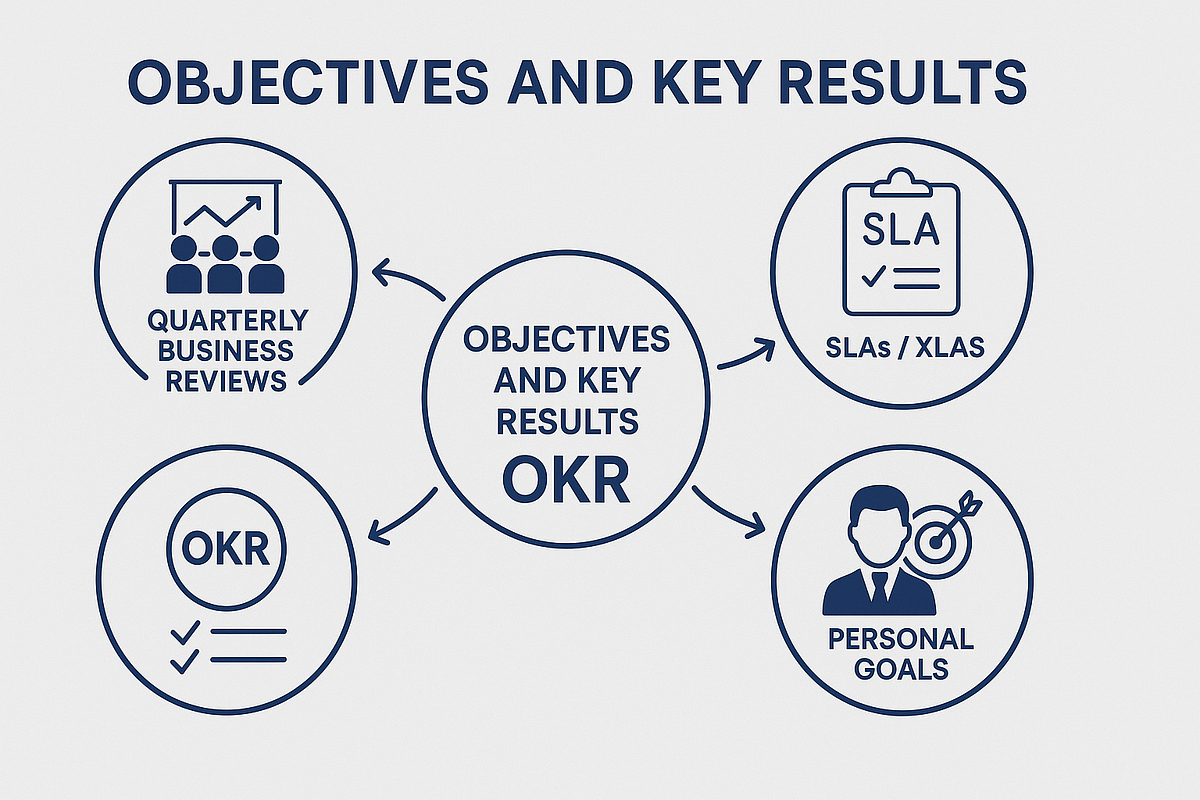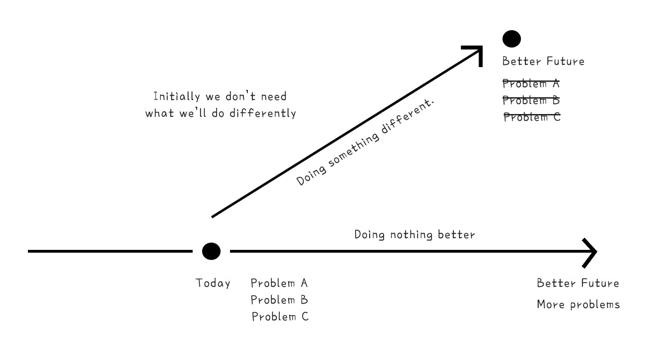Leadership News
Achievers
77

Image Credit: Achievers
Equity in the workplace: A guide to key principles and real strategies
- Workplace equity ensures fair access to opportunities, resources, and recognition for all employees.
- Equity drives higher engagement, stronger collaboration, better performance, talent attraction, and healthier workplaces.
- Transparent communication, education, leadership accountability, equal opportunities, inclusive practices, and tailored fairness are crucial.
Read Full Article
4 Likes
Medium
232

Image Credit: Medium
Software Migrations Are Not Free
- Software migrations can be complex and costly, especially when managing multiple versions simultaneously.
- Before initiating a migration, it's crucial to involve the team in discussions about supporting multiple versions.
- Strategic planning for migrations signals leadership readiness and ensures deliberate decision-making.
- When rolling out a new version, gradual adoption and clear communication with clients are key.
- Each new version commits to maintaining the old one for a period.
- Setting a time frame for migrations helps maintain momentum and stakeholder interest.
- Partial migrations are advised over all-or-nothing approaches to reduce risks.
- Assigning ownership of the migration plan within the team ensures accountability and continuity.
- Thorough documentation of migration processes and reasons is essential for future reference.
- Migration involves both technical and organizational shifts, necessitating careful planning.
- If stuck during migration, reassess remaining tasks, set new deadlines, and designate responsibility for completion.
- Success in migrations requires planning, timeboxing, and careful execution to minimize challenges.
- Migrations can be eased with proper preparation and adherence to planned timelines.
- Managing migrations diligently can lead to smoother transitions and future project success.
Read Full Article
14 Likes
Medium
323

Image Credit: Medium
Is GenAI Our Dot Com Moment?
- There is a sense of déjà vu with today's Generative AI (GenAI) explosion compared to the Dot Com era, with skyrocketing valuations and widespread FOMO.
- Key differences include the advent of Cloud Computing and Vibe Coding, but core lessons from the past remain crucial.
- Companies focusing on solving actual customer needs while balancing growth and cash efficiency are more likely to succeed.
- During the Dot Com era, many companies over-promised, lacked customer focus, and chased growth over profit, leading to failures like pets.com.
- Winning companies like Amazon, Google, and eBay played the long game, prioritizing customer problem-solving and cash efficiency.
- The GenAI Era is evolving rapidly, fueled by technologies like Cloud computing, mobile devices, and APIs.
- New startups with unicorn valuations are emerging, emphasizing the importance of solving real customer and business problems to succeed.
- AI Code Editors are disrupting the industry, enabling non-technical individuals to code and assisting software developers efficiently.
- Competition in the AI Code Editors space is intense, with companies like Cursor.ai, GitHub Copilot, and Windsurf vying for dominance.
- Lessons from the Dot Com crash are relevant today, emphasizing the need to focus on real problem-solving and financial sustainability in the GenAI hype.
- Smart leaders in the GenAI space will resist FOMO, prioritize creating lasting value, and learn from the winners and losers of the past.
Read Full Article
19 Likes
Achievers
284

Image Credit: Achievers
Cultural alignment: How to align culture at your organization
- Cultural alignment is crucial for a company's success, fostering engagement, loyalty, and productivity.
- It bridges the gap between stated values and actual employee behaviors.
- Achievers technology facilitates cultural alignment through recognition, communication, and rewards.
- Key tips for cultural alignment include defining clear values, integrating culture into daily operations, rewarding positive behaviors, and actively listening to employee feedback.
- Effective leadership plays a significant role in modeling and maintaining cultural alignment.
- Achievers offers tools for real-time recognition, continuous feedback, and insights to measure cultural alignment.
- Case studies from ATB Financial and PointClickCare demonstrate significant improvements in engagement and alignment by using Achievers.
- Cultural alignment is an ongoing process that requires consistent effort and adaptation as a company grows.
- Achievers enables companies to align their people with their purpose effectively and authentically.
- Ensuring cultural alignment leads to tangible business benefits like increased performance, engagement, and retention.
Read Full Article
17 Likes
Achievers
336

Image Credit: Achievers
Top 15 corporate culture examples of 2025
- Corporate culture examples in 2025 focus on everyday choices and deliberate effort.
- Strong cultures are built on values, recognition, innovation, and genuine engagement.
- Top companies like Achievers, Patagonia, and Google prioritize purpose, action, and well-being.
- These organizations lead with values, trust, transparency, inclusivity, and opportunities for growth.
Read Full Article
20 Likes
All Things Talent
1.1k

Image Credit: All Things Talent
Akash Somkuwar Moves Up to CEO Role at ADICO Escorts Agri Equipments
- Akash Somkuwar has been appointed as the Chief Executive Officer of ADICO Escorts Agri Equipments Pvt. Ltd., effective April 2025, to lead the company's growth.
- During his tenure as Chief Operating Officer, Somkuwar focused on operational excellence, product innovation, and strategic cohesion.
- With over 20 years of industry experience, he possesses expertise in Lean Six Sigma and Total Quality Management.
- Somkuwar is expected to drive growth, innovation, operational excellence, and customer value at ADICO Escorts.
- He will also oversee financial strategy, risk management, and profitability initiatives for sustainable transformation.
- His promotion showcases the company's commitment to internal leadership development and operational stewardship.
- ADICO Escorts anticipates enhanced performance and value-driven innovation under Somkuwar's leadership.
- Hari Menon has been named Global CHRO of Eternis Fine Chemicals in another leadership announcement.
Read Full Article
12 Likes
Hrexecutive
30

5 lessons from government layoffs the private sector can’t afford to ignore
- The Trump administration is accelerating efforts to reduce the federal workforce through layoffs and automation, with initiatives like AI.gov and AI-powered services contracts in place.
- The federal government's workforce automation serves as a valuable case study for private sector organizations considering large-scale AI deployment.
- Strategic workforce planning is crucial in the AI era to align talent with business strategy, especially when considering automation's impact on job roles.
- AI can augment human capability but understanding specific job contexts and expertise is essential for effective automation.
- Job cuts followed by reliance on AI potential do not constitute a transformation strategy; workforce planning should precede automation.
- The success of AI initiatives depends on addressing core workforce planning challenges like role clarity, knowledge capture, and governance.
- Enterprise leaders in the private sector must prioritize sustainable business value and workforce needs when planning transformation efforts.
- Lessons from government layoffs highlight the importance of proactive planning, internal skill development, data-driven decisions, flexible workforce models, and transparent communication in private sector transformation.
- Organizations observing government automation can learn to plan ahead, develop internal talent, utilize flexible workforce models, base decisions on data, and communicate change effectively.
- Private sector leaders need a strong workforce foundation to support technology advancements, as overlooking workforce planning can hinder AI implementation.
Read Full Article
1 Like
Hrexecutive
307

How Alaska Airlines earned 99.5% employee engagement, frontline workers included
- Breakdowns in communication can lower employee engagement, morale, and increase turnover rates.
- Alaska Airlines faced communication challenges across a 30,000-person workforce.
- They implemented a mobile-first platform to improve internal communication for better engagement.
- Alaska Airlines phased in the new communication strategy to ensure employee buy-in.
- Results showed a 99.5% adoption rate, exceeding expectations.
- Success factors included phased implementation, leadership communication clarity, and addressing feedback gaps.
- The platform supports regulatory compliance and real-time safety updates for frontline staff.
- Alaska Airlines focuses on enhancing employee experience through effective communication.
- The airline plans to scale the communication platform for a larger, distributed workforce.
- Efforts include improving onboarding experiences and retention strategies using technology.
Read Full Article
18 Likes
Achievers
112

Image Credit: Achievers
Employee empowerment: Definition, benefits, and tips
- Employee empowerment leads to higher engagement, innovation, and performance.
- Key aspects include trust, recognition, flexibility, feedback, and growth opportunities.
- Empowered employees are motivated, trust leadership, enhance creativity, and boost retention.
- Empowerment also drives a stronger bottom line, productivity, and customer experiences.
- Strategies for empowerment include feedback, recognition, growth opportunities, and cultural integration.
Read Full Article
6 Likes
Achievers
146

Image Credit: Achievers
Employee engagement activities that fuel purpose and performance
- Employee engagement is crucial for organizations but requires genuine efforts to be effective.
- Consistent, intentional activities are key to creating a connected, motivated workplace culture.
- Ideas include culture-building, team bonding, growth opportunities, celebrations, and lighthearted interactions.
- Meaningful recognition ties everything together, reinforcing positive behaviors and fostering long-lasting engagement.
- Engagement activities should be intentional, meeting employees' needs and supporting everyday connections.
Read Full Article
8 Likes
Achievers
138

Image Credit: Achievers
4 strategies to support employee well-being and empower teams
- Employee well-being is crucial in today's challenging work environment.
- Prioritizing well-being boosts productivity, resilience, and long-term employee engagement.
- Strategies include recognition, continuous feedback, encouraging PTO usage, and building a culture of belonging.
- Elements of well-being encompass physical, mental, social, financial, and career aspects.
- Well-being leads to better productivity, lower costs, higher retention rates, and a positive company culture.
Read Full Article
8 Likes
Salesfuel
341

Hiring Sales Reps – How To Overcome The Challenge
- Hiring sales reps has become increasingly difficult due to a lack of professionals pursuing sales careers and a mismatch in skills for today's selling environment.
- Sales is often misunderstood, with only 24% of U.S. adults considering salespeople to be credible.
- Challenges in sales roles include high quotas, pressure, demands from managers, and fear of rejection.
- Modern sales roles require strong relationship-building and consultative skills as buyers are well-informed before engaging with salespersons.
- Sales-specific assessments, like the TeamTraitTM Sales Acumen Test, can help in evaluating hard skills that are essential for success in sales.
- These assessments focus on hard skills such as discovery mindset, preparation, identifying decision-makers, and digital communication abilities.
- Soft skills like empathy, active listening, and emotional intelligence are crucial for sales success and can be evaluated through behavioral assessments.
- Internal candidates should not be overlooked for sales roles as they bring unique advantages like understanding company culture and product knowledge.
- Using the right approach in hiring, including realistic job descriptions, sales-specific assessments, evaluating hard and soft skills, and considering internal candidates, can lead to smarter hiring and better sales teams.
Read Full Article
20 Likes
Medium
323

Image Credit: Medium
The Strategic Role of Objectives and Key Results (OKRs) in Modern Organizations
- Objectives and Key Results (OKRs) are essential frameworks for aligning strategic goals with measurable outcomes in organizations, initially developed by Intel and popularized by Google.
- OKRs promote transparency, focus, and alignment across all levels of an organization, intersecting with Quarterly Business Reviews (QBRs), Service-Level Agreements (SLAs), Experience-Level Agreements (XLAs), and individual performance goals like those of a Product Owner.
- An OKR consists of a qualitative objective and quantitative key results, aiming to be ambitious yet achievable, transparent, and limited in number to maintain focus, with a typical quarterly cadence.
- OKRs and QBRs work together to support organizational agility and accountability by reviewing performance metrics and adjusting efforts based on progress towards objectives.
- Service-Level Agreements (SLAs) and Experience-Level Agreements (XLAs) set operational performance and user satisfaction standards, connected to broader business goals through OKRs.
- OKRs play a significant role for individual roles like Product Owners (POs) in demonstrating alignment with company goals, prioritizing initiatives effectively, and measuring contributions objectively.
- To maximize the value of OKRs, organizations should follow best practices by integrating them with high-level strategy, reinforcing business agility with QBRs, ensuring operational excellence with SLAs and XLAs, and empowering individuals like Product Owners to deliver strategic value.
Read Full Article
19 Likes
Medium
146

Image Credit: Medium
In a world where wars can be won or lost in minutes, nuclear weapons remain the most powerful tools…
- Supporters of nuclear equality are advocating for equal rules where any country threatening peace faces consequences regardless of its power or alliance.
- Critics argue that denying other countries nuclear capabilities perpetuates weakness and fuels hidden programs.
- Advocates stress the importance of global transparency and joint responsibility in managing nuclear weapons.
- The call is for a fair and transparent approach to security that holds all countries accountable and responds collectively to aggression.
- The article highlights the need for a shift towards a just system that ensures a balance of power and equal sovereignty.
Read Full Article
8 Likes
Hackernoon
284

Image Credit: Hackernoon
What You See Isn't Always What You Get: The Hidden Strategy Behind Product Design
- Product design goes beyond engineering, impacting performance and consumer perception.
- Product architecture is influenced by factors like firm prestige and customer sophistication.
- Integral, slot, bus, and sectional are core archetypes defining product design interdependency.
- Decisions about product architecture have strategic implications beyond traditional engineering focus.
- Consumer perception of product design can differ from its actual engineering reality.
- Consumer preferences and firm status play key roles in product architecture decisions.
- High-status firms aim for perceived integral design even with bus or sectional engineering.
- The study proposes strategic matrix for optimal product design based on firm status and consumer sophistication.
- Insights from the research suggest the importance of forming alliances and leveraging status in product design.
- Methodology involved qualitative research and data collection to uncover nuances in product architecture decisions.
Read Full Article
17 Likes
For uninterrupted reading, download the app